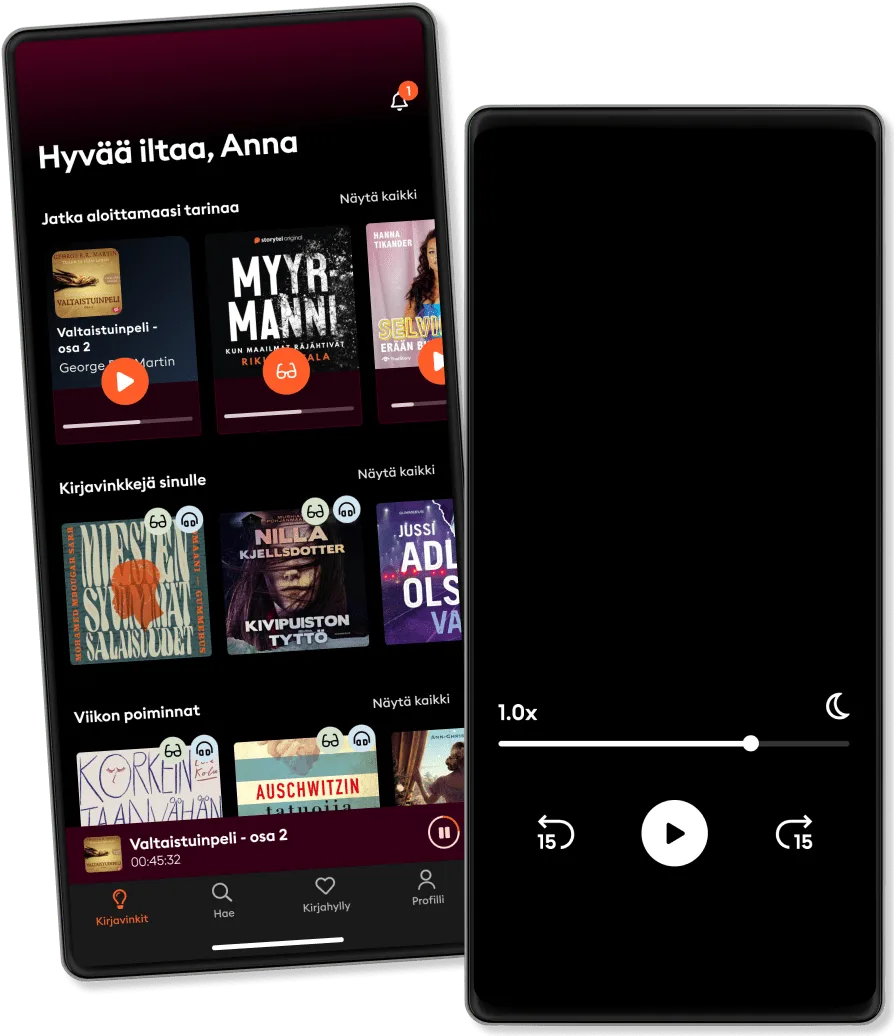Black week: Nyt 3 kk -50%
Astu tarinoiden maailmaan
- Pohjoismaiden suosituin ääni- ja e-kirjapalvelu
- Uppoudu suureen valikoimaan äänikirjoja ja e-kirjoja
- Storytel Original -sisältöjä yksinoikeudella
- Ei sitoutumisaikaa

Nazi Propaganda Through Art & Architecture: Creating the Myth of Hitler's Third Reich
- Kirjailija
- Julkaisija
- Kielet
- Englanti
- Formaatti
- Kategoria
Historia
Norman Ridley explores how Hitler's artistic and architectural vision for Germany led to the monumental structures which we now associate with the Third Reich. When the Nazis came to power in January 1933, they began a program of transforming Germany from a democracy into a totalitarian state, but it was not a matter of simply enforcing compliance. The people had to be coaxed into believing in the new regime. Hearts and minds had to be won over and one of the ways the Nazis did that was to create an ideal of German nationhood in which everyone could feel proud. This was especially the case with art, which came to be used as a powerful tool of propaganda both to disseminate the myth amongst the population and indicate to the Nazi administrators the sort of cultural environment they should create. It was not an easy thing to do. While the nation was being re-created as a dynamic, modern, and powerful industrial giant, all the signals coming from Hitler indicated that his own idyllic view of the German nation was of a traditional, rural people deep-rooted in a romantic-mystical aesthetic. Hitler's own experience as an artist in Vienna before the First World War had shown that, while technically proficient, his work was detached and impersonal. Despite being rejected by the Vienna Academy of Fine Arts he continued to see himself as artistically gifted, especially in the field of architecture. This book looks at how the artistic side of Hitler's personality dominated Nazi aesthetics and the ways in which the Third Reich manipulated public opinion and advanced its political agenda using the power of art. Despite his early setbacks, Hitler always thought of himself first and foremost an artist. He would frequently break off discussions with diplomats and soldiers to veer off on a lecture about his ideas on art and architecture which had been formed during his time in Vienna. Nazi Propaganda Through Art and Architecture explores how Hitler's artistic and architectural vision for Germany led to the monumental structures which we now associate with the Third Reich, alongside the rural idyl he sought to espouse, and how they came to symbolise the re-emergent power of a German nation which would dominate Europe.
© 2025 Frontline Books (E-kirja): 9781036100230
Julkaisupäivä
E-kirja: 4. marraskuuta 2025
Avainsanat
Saattaisit pitää myös näistä
- Erikoisjoukoissa – Janne Lehtosen tarina Kati Pukki
4.6
- Niko: Kaikki mitä en ole kertonut Mari Koppinen
4.2
- Hupparizombi Eve Hietamies
4.3
- Henna Björk: Hydra Christian Rönnbacka
4.2
- JHT – Missio vai mielenrauha Oskari Saari
4.3
- Ei sinun lapsesi Nilla Kjellsdotter
4
- Mira Óskar Guðmundsson
3.7
- Matriarkka Enni Mustonen
4
- Liekki Tuomas Milonoff
4.2
- Herta 3 Anna Sundbeck Klav
4.1
- Myrskynsilmä: Empyreum 3 Rebecca Yarros
4.2
- Viimeinen vääntö Seppo Jokinen
4.4
- Tom Sjöberg – Rööperin katupoika Lamppu Laamanen
3.9
- Pyykkipäivä Maija Kajanto
4
- Yhden kesän juttu Abby Jimenez
4.1
Valitse tilausmalli
Yli miljoona tarinaa
Suosituksia juuri sinulle
Uusia Storytel Originals + eksklusiivisia sisältöjä kuukausittain
Turvallinen Kids Mode
Ei sitoutumisaikaa
Standard
Sinulle joka kuuntelet säännöllisesti.
1 käyttäjätili
50 tuntia/kuukausi
Ei sitoutumisaikaa
Premium
Sinulle joka kuuntelet ja luet usein.
1 käyttäjätili
100 tuntia/kuukausi
Ei sitoutumisaikaa
Flex
Sinulle joka kuuntelet vähemmän.
1 käyttäjätili
20 tuntia/kuukausi
Säästä käyttämättömät tunnit, max 20h
Ei sitoutumisaikaa
Unlimited
Sinulle joka haluat rajattomasti tarinoita.
1 käyttäjätili
Kuuntele ja lue rajattomasti
Ei sitoutumisaikaa
Family
Kun haluat jakaa tarinoita perheen kanssa.
2-6 tiliä
100 tuntia/kk jokaiselle käyttäjälle
Ei sitoutumisaikaa
2 käyttäjätiliä
26.99 € /kuukausiSuomi
Suomi